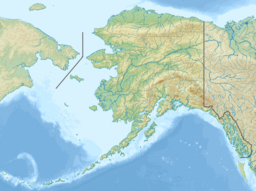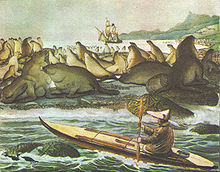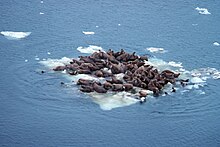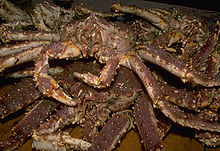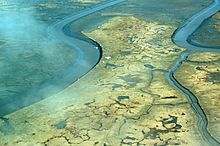Смотреть что такое БЕРИНГОВО МОРЕ в других словарях:
БЕРИНГОВО МОРЕ
или Камчатское море — северо-восточная часть Тихого океана, ограниченная с запада Северной Америкой, а с востока Азией и сообщающаяся с Северным Ледови… смотреть
БЕРИНГОВО МОРЕ
(по имени мореплавателя В. Беринга полузамкнутое море Тихого океана между материками Азии на З. (СССР), Северной Америки на В. (США) и Командорс… смотреть
БЕРИНГОВО МОРЕ
БЕРИНГОВО МОРЕ (по имени мореплавателя
В. Беринга), полузамкнутое море Тихого ок. между материками Азии
на 3. (СССР), Сев. Америки на В. (США) и Кома… смотреть
БЕРИНГОВО МОРЕ
Берингово море или Камчатское море — северо-восточная часть Тихого океана, ограниченная с запада Северной Америкой, а с востока Азией и сообщающаяся с Северным Ледовитым океаном посредством Берингова пролива. Самую узкую часть этого пролива составляет промежуток между Северо-Восточным мысом Азии и мысом Принца Валлийского в Америке, в общем же ширина его около 75—22 км, длина 40—60 м и глубина 50—90 м. В той же, наиболее узкой, части находятся три Диомидийские о-ва, а к Ю. от них большой о-в Св. Лаврентия. В средней части пролива господствует течение с Ю. на С., по обоим же бокам — в сторону обратную. Отвесные, глубоко изрезанные берега необитаемы. И пролив, и северная часть Б. моря, пересекаемые Сев. Полярным кругом, зимой сплошь покрыты льдом. Б. пролив открыт в 1728 г. мореплавателем Берингом, по имени которого он и назван, но еще в 1648 г. казак Дежнев заходил сюда, охотясь за пушным зверем, и исследовал все северное побережье до устья Анадыря.<br><br><br>… смотреть
БЕРИНГОВО МОРЕ
Берингово море
Тихий океан, между Азией (Россия: Чукотский и Корякский ао, Камчатская обл.) и Сев. Америкой (США, Аляска). Названо в честь капитан-… смотреть
БЕРИНГОВО МОРЕ
БЕРИНГОВО МОРЕ названо так кап. Головиным в честь русскаго капитан-командора В. Беринга. Б. море, ограниченное с ю. о-вами Алеутскими и Командорски… смотреть
БЕРИНГОВО МОРЕ
Берингово море — полузамкнутое море Тихого океана, между Азией и Северной Америкой, от океана отделено Алеутскими и Командорскими островами. Беринговым… смотреть
БЕРИНГОВО МОРЕ
Берингово море — полузамкнутое море на С. Тихого океана, между Азией и Сев. Америкой, от океана отделено Алеутскими и Командорскими о-вами. Беринго… смотреть
БЕРИНГОВО МОРЕ
БЕРИНГОВО МОРЕ, полузамкнутое море на севере Тихого океана, отделено от него Алеутскими и Командорскими о-вами. 2315 тыс. км2. Наибольшая глуб. 5500 м… смотреть
БЕРИНГОВО МОРЕ
1) Орфографическая запись слова: берингово море2) Ударение в слове: Б`ерингово м`оре3) Деление слова на слоги (перенос слова): берингово море4) Фонетич… смотреть
БЕРИНГОВО МОРЕ
Бе́рингово мо́ре, полузамкнутое море Тихого океана, между Азией (Россия) и Северной Америкой (США); отделено от основной части океана Алеутскими и … смотреть
БЕРИНГОВО МОРЕ
полузамкнутое море на С. Тихого ок. между берегами Азии и Сев. Америки. От океана отделено Алеутскими и Командорскими о-вами. Пл. 2315 тыс. км2, преобл… смотреть
БЕРИНГОВО МОРЕ
БЕРИНГОВО море — полузамкнутое море на севере Тихого ок., отделено от него Алеутскими и Командорскими о-вами. 2315 тыс. км². Наибольшая глубина 550… смотреть
БЕРИНГОВО МОРЕ
БЕРИНГОВО МОРЕ, полузамкнутое море на севере Тихого ок., отделено от него Алеутскими и Командорскими о-вами. 2315 тыс. км2. Наибольшая глубина 5500 м, на севере менее 200 м. Крупные заливы: Анадырский и Олюторский (у побережья Российской Федерации), Нортон, Бристольский (Аляска, США). Зимой покрыто льдом. Крупные острова: Карагинский, Св. Лаврентия, Нунивак, Прибылова. Впадают рр. Анадырь и Юкон. Соленость 30-33‰. Рыболовство (лососевые, камбаловые, сельдь, сайра), промысел морских котиков, тюленей. На берегах и островах птичьи базары. Порты: Провидения (Российская Федерация), Ном (США). Названо по имени В. Беринга.<br><br><br>… смотреть
БЕРИНГОВО МОРЕ
Bering Sea, узкая акватория в сев. части Тихого океана, расположенная между Сибирью и Аляской и ограниченная с Ю. Алеутскими о-вами. Соединяется с Севе… смотреть
БЕРИНГОВО МОРЕ
БЕРИНГОВО МОРЕ, полузамкнутое море на севере Тихого ок., отделено от него Алеутскими и Командорскими о-вами. 2315 тыс. км2. Наибольшая глубина 5500 м, на севере менее 200 м. Крупные заливы: Анадырский и Олюторский (у побережья Российской Федерации), Нортон, Бристольский (Аляска, США).
Зимой покрыто льдом. Крупные острова: Карагинский, Св. Лаврентия, Нунивак, Прибылова. Впадают рр. Анадырь и Юкон. Соленость 30-33‰. Рыболовство (лососевые, камбаловые, сельдь, сайра), промысел морских котиков, тюленей. На берегах и островах птичьи базары. Порты: Провидения (Российская Федерация), Ном (США). Названо по имени В. Беринга…. смотреть
БЕРИНГОВО МОРЕ
БЕРИНГОВО МОРЕ , полузамкнутое море на севере Тихого ок., отделено от него Алеутскими и Командорскими о-вами. 2315 тыс. км2. Наибольшая глубина 5500 м, на севере менее 200 м. Крупные заливы: Анадырский и Олюторский (у побережья Российской Федерации), Нортон, Бристольский (Аляска, США). Зимой покрыто льдом. Крупные острова: Карагинский, Св. Лаврентия, Нунивак, Прибылова. Впадают рр. Анадырь и Юкон. Соленость 30-33‰. Рыболовство (лососевые, камбаловые, сельдь, сайра), промысел морских котиков, тюленей. На берегах и островах птичьи базары. Порты: Провидения (Российская Федерация), Ном (США). Названо по имени В. Беринга…. смотреть
БЕРИНГОВО МОРЕ
— полузамкнутое море на севере Тихого ок., отделено от негоАлеутскими и Командорскими о-вами. 2315 тыс. км2. Наибольшая глубина 5500м, на севере менее 200 м. Крупные заливы: Анадырский и Олюторский (упобережья Российской Федерации), Нортон, Бристольский (Аляска, США). Зимойпокрыто льдом. Крупные острова: Карагинский, Св. Лаврентия, Нунивак,Прибылова. Впадают рр. Анадырь и Юкон. Соленость 30-33.. Рыболовство(лососевые, камбаловые, сельдь, сайра), промысел морских котиков, тюленей.На берегах и островах птичьи базары. Порты: Провидения (РоссийскаяФедерация), Ном (США). Названо по имени В. Беринга…. смотреть
БЕРИНГОВО МОРЕ
БЕРИНГОВО МОРЕ Тихого океана, между Евразией и Северной Америкой, ограничено с юга Алеутскими и Командорскими островами. Соединяется с Чукотским морем Беринговым проливом. Площадь 2315 тыс. км2. Глубина до 5500 м. Крупные острова: Святого Лаврентия, Нунивак. Крупные заливы: Анадырский, Олюторский, Нортон, Бристольский. Впадают реки Анадырь и Юкон. Большую часть года покрыто плавучими льдами. Рыболовство (лосось, камбала, сельдь). Порты: Провидения (Россия), Ном (США). <br>… смотреть
БЕРИНГОВО МОРЕ
Тихого океана, между Евразией и Северной Америкой, ограничено с юга Алеутскими и Командорскими островами. Соединяется с Чукотским морем Беринговым проливом. Площадь 2315 тыс. км<sup>2</sup>. Глубина до 5500 м. Крупные острова: Святого Лаврентия, Нунивак. Крупные заливы: Анадырский, Олюторский, Нортон, Бристольский. Впадают реки Анадырь и Юкон. Большую часть года покрыто плавучими льдами. Рыболовство (лосось, камбала, сельдь). Порты: Провидения (Россия), Ном (США)…. смотреть
БЕРИНГОВО МОРЕ
Ударение в слове: Б`ерингово м`ореУдарение падает на буквы: е,оБезударные гласные в слове: Б`ерингово м`оре
БЕРИНГОВО МОРЕ
полузамкнутое море Тихого океана, между Азией (Россия) и Северной Америкой (США); отделено от основной части океана Алеутскими и Командорскими островами. Беринговым проливом соединяется с Чукотским морем. Площадь 2315 тыс. кв. км…. смотреть
Как правильно пишется словосочетание «Берингово море»
Бе́рингово мо́ре
Бе́рингово мо́ре, Бе́рингова мо́ря
Источник: Орфографический
академический ресурс «Академос» Института русского языка им. В.В. Виноградова РАН (словарная база
2020)
Делаем Карту слов лучше вместе
Привет! Меня зовут Лампобот, я компьютерная программа, которая помогает делать
Карту слов. Я отлично
умею считать, но пока плохо понимаю, как устроен ваш мир. Помоги мне разобраться!
Спасибо! Я стал чуточку лучше понимать мир эмоций.
Вопрос: зубовный — это что-то нейтральное, положительное или отрицательное?
Ассоциации к слову «море»
Синонимы к слову «море»
Предложения со словосочетанием «Берингово море»
- За китом всплыли клубы ила – Берингово море здесь было мелководно.
- Берингово море переливалось, просвечивало, млело и сверкало под солнцем и само по себе источало жару и пресыщенность жизнью.
- (все предложения)
Цитаты из русской классики со словосочетанием «Берингово море»
- С закатом солнца ветер засвежел, небо покрылось тучами, и море еще более взволновалось. Сквозь мрак виднелись белые гребни волн, слабо фосфоресцирующие. Они с оглушительным грохотом бросались на берег. Всю ночь металось море, всю ночь гремела прибрежная галька и в рокоте этом слышалось что-то неумолимое, вечное.
- — Видишь, я прав, — сказал опять слепой, ударив в ладоши, — Янко не боится ни моря, ни ветров, ни тумана, ни береговых сторожей; прислушайся-ка: это не вода плещет, меня не обманешь, — это его длинные весла.
- В другом я — новый аргонавт, в соломенной шляпе, в белой льняной куртке, может быть с табачной жвачкой во рту, стремящийся по безднам за золотым руном в недоступную Колхиду, меняющий ежемесячно климаты, небеса, моря, государства.
- (все
цитаты из русской классики)
Значение слова «море»
-
МО́РЕ, -я, мн. моря́, —е́й, ср. 1. Часть Мирового океана, более или менее обособленная сушей или возвышенностями подводного рельефа. Балтийское море. Средиземное море. (Малый академический словарь, МАС)
Все значения слова МОРЕ
Афоризмы русских писателей со словом «море»
- Сколько бы ни смотреть на море — оно никогда не надоест. Оно всегда разное, новое, невиданное.
Оно меняется на глазах каждый час. - Как выходят в открытое море,
Мы в открытое время войдем. - Давайте перемолвим
безмолвье синих молний,
давайте снова новое
любить начнем.
Чтоб жизнь опять сначала,
как море, закачала.
Давай? Давай!
Давай начнем! - (все афоризмы русских писателей)
Отправить комментарий
Дополнительно
Русский[править]
Тип и синтаксические свойства сочетания[править]
Бе́рингово мо́—ре
Устойчивое сочетание (гидроним). Используется в качестве именной группы.
Произношение[править]
- МФА: [ˈbʲerʲɪnɡəvə ˈmorʲɪ]
Семантические свойства[править]
Значение[править]
- море на севере Тихого океана ◆ Пятница, 21. Берингово море Славный французский гидрограф г-н Флиорье в распределении своем именований разным морям назвал пространство вод, заключающееся между грядою Алеутских островов и берегами Азии и Америки к северу, Беринговым ковшом (Bassin de Bering) как потому, что Беринг первый открыл сие море, так и для того, что прах сего мужа покоится на одном из островов оного. По сим причинам название Берингова моря мне показалось справедливым и приличным. В. М. Головнин, «Путешествие вокруг света, совершенное на военном шлюпе в 1817, 1818 и 1819 годах флота капитаном Головниным», 1822 г.
Синонимы[править]
- истор. Камчатское море, Бобровое море
Антонимы[править]
- —
Гиперонимы[править]
- море
Гипонимы[править]
- —
Этимология[править]
Море было названо в честь мореплавателя Витуса Беринга, под руководством которого оно исследовалось в 1725—1743 годах. Впервые имя Беринга дляэтой акватории было предложено французским географом Ш. П. Флиорье в начале XIX века, однако в обиход было введено только в 1818 году русским мореплавателем В. М. Головниным.
Перевод[править]
| Список переводов | |
|
Библиография[править]
From Wikipedia, the free encyclopedia
| Bering Sea | |
|---|---|
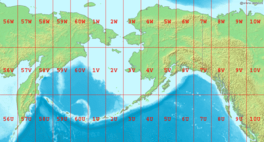
Map showing the location of the Bering Sea with latitude and longitude zones of the Universal Transverse Mercator coordinate system |
|
|
Bering Sea |
|
| Coordinates | 58°0′N 178°0′W / 58.000°N 178.000°WCoordinates: 58°0′N 178°0′W / 58.000°N 178.000°W |
| Basin countries | Russia and United States |
| Surface area | 2,000,000 km2 (770,000 sq mi) |
The Bering Sea (, ;[1][2][3] Russian: Бе́рингово мо́ре, tr. Béringovo móre) is a marginal sea of the Northern Pacific Ocean. It forms, along with the Bering Strait, the divide between the two largest landmasses on Earth: Eurasia and The Americas.[4][5] It comprises a deep water basin, which then rises through a narrow slope into the shallower water above the continental shelves. The Bering Sea is named after Vitus Bering, a Danish navigator in Russian service, who, in 1728, was the first European to systematically explore it, sailing from the Pacific Ocean northward to the Arctic Ocean.[6]
The Bering Sea is separated from the Gulf of Alaska by the Alaska Peninsula. It covers over 2,000,000 square kilometers (770,000 sq mi) and is bordered on the east and northeast by Alaska, on the west by the Russian Far East and the Kamchatka Peninsula, on the south by the Alaska Peninsula and the Aleutian Islands and on the far north by the Bering Strait, which connects the Bering Sea to the Arctic Ocean’s Chukchi Sea.[7] Bristol Bay is the portion of the Bering Sea between the Alaska Peninsula and Cape Newenham on mainland Southwest Alaska.
The Bering Sea ecosystem includes resources within the jurisdiction of the United States and Russia, as well as international waters in the middle of the sea (known as the «Donut Hole»[8]). The interaction between currents, sea ice, and weather makes for a vigorous and productive ecosystem.
History[edit]
Most scientists think that during the most recent ice age, sea level was low enough to allow humans to migrate east on foot from Asia to North America across what is now the Bering Strait. Other animals including megafauna migrated in both directions. This is commonly referred to as the «Bering land bridge» and is accepted by most, though not all scientists, to be the first point of entry of humans into the Americas.
There is a small portion of the Kula Plate in the Bering Sea. The Kula Plate is an ancient tectonic plate that used to subduct under Alaska.[9]
On 18 December 2018, a large meteor exploded above the Bering Sea. The meteor exploded at an altitude of 25.6km releasing 49 kilotons of energy.[10][11]
Geography[edit]
Bering Sea showing the larger of the submarine canyons that cut the margin
Extent[edit]
The International Hydrographic Organization defines the limits of the Bering Sea as follows:[12]
-
- On the North. The Southern limit of the Chuckchi Sea [sic] [The Arctic Circle between Siberia and Alaska].
-
- On the South. A line running from Kabuch Point (54°48′N 163°21′W / 54.800°N 163.350°W) in the Alaskan Peninsula, through the Aleutian Islands to the South extremes of the Komandorski Islands and on to Cape Kamchatka in such a way that all the narrow waters between Alaska and Kamchatka are included in the Bering Sea.
Islands[edit]
Islands of the Bering Sea include:
- Pribilof Islands, including St. Paul Island
- Komandorski Islands, including Bering Island
- St. Lawrence Island
- Diomede Islands
- King Island
- St. Matthew Island
- Karaginsky Island
- Nunivak Island[13]
- Sledge Island[14]
- Hagemeister Island[15]
Regions[edit]
Regions of the Bering Sea include:
- Bering Strait
- Bristol Bay
- Gulf of Anadyr
- Norton Sound
The Bering Sea contains 16 submarine canyons including the largest submarine canyon in the world, Zhemchug Canyon.
The Russian «Rurik» sets anchor near Saint Paul Island in the Bering sea in order to load food and equipment for the expedition to the Chukchi sea in the north. Drawing by Louis Choris in 1817.
Walrus (Odobenus rosmarus divergens), hauled out on Bering Sea ice, Alaska, June 1978. (Source: NOAA)
Snailfish, a non-commercial fish, caught in the eastern Bering Sea
Aerial view of Tutakoke Bird Camp on the coast of the Bering Sea, south of Hooper Bay
Ecosystem[edit]
The Bering Sea shelf break is the dominant driver of primary productivity in the Bering Sea.[16] This zone, where the shallower continental shelf drops off into the North Aleutians Basin is also known as the «Greenbelt». Nutrient upwelling from the cold waters of the Aleutian basin flowing up the slope and mixing with shallower waters of the shelf provide for constant production of phytoplankton.
The second driver of productivity in the Bering Sea is seasonal sea ice that, in part, triggers the spring phytoplankton bloom. Seasonal melting of sea ice causes an influx of lower salinity water into the middle and other shelf areas, causing stratification and hydrographic effects which influence productivity.[17] In addition to the hydrographic and productivity influence of melting sea ice, the ice itself also provides an attachment substrate for the growth of algae as well as interstitial ice algae.[citation needed]
Some evidence suggests that great changes to the Bering Sea ecosystem have already occurred. Warm water conditions in the summer of 1997 resulted in a massive bloom of low energy coccolithophorid phytoplankton (Stockwell et al. 2001). A long record of carbon isotopes, which is reflective of primary production trends of the Bering Sea, exists from historical samples of bowhead whale baleen.[18] Trends in carbon isotope ratios in whale baleen samples suggest that a 30–40% decline in average seasonal primary productivity has occurred over the last 50 years.[18] The implication is that the carrying capacity of the Bering Sea is much lower now than it has been in the past.
Biodiversity[edit]
The sea supports many whale species, including the beluga, humpback whale, bowhead whale, gray whale and blue whale, the vulnerable sperm whale, and the endangered fin whale, sei whale and the rarest in the world, the North Pacific right whale. Other marine mammals include walrus, Steller sea lion, northern fur seal, orca and polar bear.[19][20]
The Bering Sea is very important to the seabirds of the world. Over 30 species of seabirds and approximately 20 million individuals breed in the Bering Sea region.[citation needed][21] Seabird species include tufted puffins, the endangered short-tailed albatross, spectacled eider, and red-legged kittiwakes.[22][23] Many of these species are unique to the area, which provides highly productive foraging habitat, particularly along the shelf edge and in other nutrient-rich upwelling regions, such as the Pribilof, Zhemchug, and Pervenets canyons. The Bering Sea is also home to colonies of crested auklets, with upwards of a million individuals.[citation needed]
Two Bering Sea species, the Steller’s sea cow (Hydrodamalis gigas) and spectacled cormorant (Phalacrocorax perspicillatus), are extinct because of overexploitation by man. In addition, a small subspecies of Canada goose, the Bering Canada goose (Branta canadensis asiatica) is extinct due to overhunting and the introduction of rats to their breeding islands.
The Bering Sea supports many species of fish, some of which support large and valuable commercial fisheries. Commercial fish species include Pacific cod, several species of flatfish, sablefish, Pacific salmon, and Pacific herring. Shellfish include red king crab and snow crab.[24]
Fish biodiversity is high, and at least 419 species of fish have been reported from the Bering Sea.
Fisheries[edit]
The Bering Sea is world-renowned for its productive and profitable fisheries, such as king crab,[25] opilio and tanner crabs, Bristol Bay salmon, pollock and other groundfish.[26][27] These fisheries rely on the productivity of the Bering Sea via a complicated and little understood food web.
Commercial fishing is lucrative business in the Bering Sea, which is relied upon by the largest seafood companies in the world to produce fish and shellfish.[28] On the U.S. side, commercial fisheries catch approximately $1 billion worth of seafood annually, while Russian Bering Sea fisheries are worth approximately $600 million annually.[citation needed]
The Bering Sea also serves as the central location of the Alaskan king crab and snow crab seasons, which are chronicled on the Discovery Channel television program Deadliest Catch. Landings from Alaskan waters represents half the U.S. catch of fish and shellfish.[citation needed]
Change[edit]
Because of the changes going on in the Arctic, the future evolution of the Bering Sea climate and ecosystem is uncertain.[29] Between 1979 and 2012, the region experienced small growth in sea ice extent, standing in contrast to the substantial loss of summer sea ice in the Arctic Ocean to the north.[30]
In media[edit]
‘The White Seal’, one of many chapters on Rudyard Kipling’s The Jungle Book, features the Bering Sea as the birthplace and homeland of Kotick, a rare white fur seal.
The film Harbinger Down, which was released on August 7, 2015, was about a group of grad students who booked passage on the crabbing boat Harbinger to study the effects of global warming on a pod of beluga whales in the Bering Sea.[31]
One of the central characters in the 1949 film Down to the Sea in Ships has the given name «Bering» due to having been born in a ship crossing the Bering Sea.[32]
The 2002 supernatural thriller, Ghost Ship, directed by Steve Beck, follows a marine salvage crew in the Bering Sea who discover the lost Italian ocean liner, Antonia Graza that disappeared in 1962.
Gallery[edit]
-
In the top-right corner of the image is Alaska’s mainland blanketed with snow, as well as Nunivak Island. At the centre of the image are the islands of Saint Paul and Saint George – part of the Pribilof Islands. Also note the von Kármán vortex street (swirly clouds) in the middle right.
-
Satellite photo of the Bering Sea – Alaska is on the top right, Siberia on the top left
-
Bering Sea in the North Pacific Ocean
See also[edit]
- Beringia — name for the dry land that included the northeast third of today’s Bering Sea during the last Ice Age
- Bering Sea Arbitration
- List of seas
- Northern Bering Sea Climate Resilience Area
- Timeline of environmental events
References[edit]
- ^ Jones, Daniel (2011). Roach, Peter; Setter, Jane; Esling, John (eds.). Cambridge English Pronouncing Dictionary (18th ed.). Cambridge University Press. ISBN 978-0-521-15255-6.
- ^ Wells, John C. (2008). Longman Pronunciation Dictionary (3rd ed.). Longman. ISBN 978-1-4058-8118-0.
- ^ «Bering». Merriam-Webster Dictionary. Retrieved 19 September 2020.
- ^ Fasham, M. J. R. (2003). Ocean biogeochemistry: the role of the ocean carbon cycle in global change. Springer. p. 79. ISBN 978-3-540-42398-0.
- ^ McColl, R.W. (2005). Encyclopedia of World Geography. Infobase Publishing. p. 697. ISBN 978-0-8160-5786-3. Retrieved 26 November 2010.
- ^ «Vitus Bering». Encyclopaedia Britannica. Retrieved 2018-12-21.
- ^ «Area of Bering sea». Encyclopaedia Britannica. Retrieved 2018-12-21.
- ^ «North Pacific Overfishing (DONUT)». Trade Environment Database. American University. Archived from the original on 9 April 2011. Retrieved 13 August 2011.
- ^ Steinberger, Bernhard, and Carmen Gaina Geology 35 (5) 407-410, 2007 Plate-tectonic reconstructions predict part of the Hawaiian hotspot tract to be preserved in the Bering Sea
- ^ «Fireballs». cneos.jpl.nasa.gov. Retrieved 10 September 2022.
- ^ Rincon, Paul (18 March 2019). «US detects huge meteor explosion». BBC News.
- ^ «Limits of Oceans and Seas, 3rd edition» (PDF). International Hydrographic Organization. 1953. Archived from the original (PDF) on 8 October 2011. Retrieved 28 December 2020.
- ^ «Nunivak island in Bering sea». Encyclopaedia Britannica. Retrieved 2018-12-21.
- ^ «Alaska Islands of Bering Sea». www.stateofalaskaguide.com. Retrieved 24 April 2018.
- ^ «Wilderness.net — Bering Sea Wilderness — General Information». Wilderness.net. Retrieved 24 April 2018.
- ^ Springer, A. M.; McRoy, C. P.; Flint, M. V. (1996). «The Bering Sea Green Belt: Shelf-edge processes and ecosystem production». Fisheries Oceanography. 5 (3–4): 205. doi:10.1111/j.1365-2419.1996.tb00118.x.
- ^ Schumacher, J. D.; Kinder, T. H.; Pashinski, D. J.; Charnell, R. L. (1979). «A Structural Front over the Continental Shelf of the Eastern Bering Sea». Journal of Physical Oceanography. 9 (1): 79. Bibcode:1979JPO…..9…79S. doi:10.1175/1520-0485(1979)009<0079:ASFOTC>2.0.CO;2.
- ^ a b Schell, D. M. (2000). «Declining carrying capacity in the Bering Sea: Isotopic evidence from whale baleen». Limnology and Oceanography. 45 (2): 459–462. Bibcode:2000LimOc..45..459S. doi:10.4319/lo.2000.45.2.0459.
- ^ Citta, John J.; Burns, John J.; Quakenbush, Lori T.; Vanek, Vicki; George, John C.; Small, Robert J.; Heide-Jørgensen, Mads Peter; Brower, Harry (12 June 2013). «Potential for bowhead whale entanglement in cod and crab pot gear in the Bering Sea». Marine Mammal Science. 30 (2): 445–459. doi:10.1111/mms.12047.
- ^ «Humpback Whales in Alaska». www.whale-watching-alaska.com. Retrieved 24 April 2018.
- ^ «Eco region based conservation in the Bering sea» (PDF). Protected areas. Archived (PDF) from the original on 2022-02-11.
- ^ «Hundreds of Tufted Puffin Deaths Suggest Dangers of Warming Seas». Audubon. 23 November 2016. Retrieved 24 April 2018.
- ^ «Red-legged Kittiwake». Audubon. 13 November 2014. Retrieved 24 April 2018.
- ^ «Bering Sea & Aleutian Islands». Alaska Department of Fish and Game. Retrieved April 4, 2020.
- ^ Red King Crab, Paralithodes camtschaticus Alaska Fisheries Science Center. Retrieved 2007-04-07.
- ^ Bering Climate. noaa.gov
- ^ «Groundfish Fisheries in the Eastern Bering Sea». Arctic Program. Retrieved 24 April 2018.
- ^ Fisheries, NOAA (2019-05-24). «Sustainable Fisheries in Alaska | NOAA Fisheries». www.fisheries.noaa.gov. Retrieved 2019-06-16.
- ^ Providing information on the present state of Arctic ecosystems and climate in historical context. arctic.noaa.gov
- ^ Alex DeMarban (19 February 2014). «In a warming world, Alaska’s icy Bering Sea bucks the trend». Alaska Dispatch. Retrieved 26 September 2014.
- ^ «Harbinger Down». 7 August 2015 – via www.imdb.com.
- ^ «Down to the Sea in Ships (1949) with Richard Widmark — Classic Film Freak». Classic Film Freak. 14 December 2010. Retrieved 24 April 2018.
Further reading[edit]
- Demuth, Bathsheba (2020). Floating Coast: An Environmental History of the Bering Strait. New York: W. W. Norton & Company. ISBN 0-393-63516-3. OCLC 1091237096.
External links[edit]
- Bering Sea Climate and Ecosystem from NOAA
- North Pacific Ocean theme page from NOAA
- Groundfish fisheries and harvest, 2005 from Alaska Department of Fish and Game
- Video of research on Bering Sea
- Nautical Chart of the Bering Sea (Southern Part)


